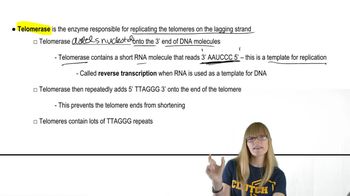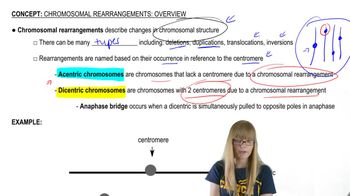Provide a comprehensive definition of heterochromatin and list as many examples as you can.
Table of contents
- 1. Introduction to Genetics51m
- 2. Mendel's Laws of Inheritance3h 37m
- 3. Extensions to Mendelian Inheritance2h 41m
- 4. Genetic Mapping and Linkage2h 28m
- 5. Genetics of Bacteria and Viruses1h 21m
- 6. Chromosomal Variation1h 48m
- 7. DNA and Chromosome Structure56m
- 8. DNA Replication1h 10m
- 9. Mitosis and Meiosis1h 34m
- 10. Transcription1h 0m
- 11. Translation58m
- 12. Gene Regulation in Prokaryotes1h 19m
- 13. Gene Regulation in Eukaryotes44m
- 14. Genetic Control of Development44m
- 15. Genomes and Genomics1h 50m
- 16. Transposable Elements47m
- 17. Mutation, Repair, and Recombination1h 6m
- 18. Molecular Genetic Tools19m
- 19. Cancer Genetics29m
- 20. Quantitative Genetics1h 26m
- 21. Population Genetics50m
- 22. Evolutionary Genetics29m
7. DNA and Chromosome Structure
Eukaryotic Chromosome Structure
Problem 16c
Textbook Question
The accompanying chromosome diagram represents a eukaryotic chromosome prepared with Giemsa stain. Indicate the heterochromatic and euchromatic regions of the chromosome, and label the chromosome's centromeric and telomeric regions.

Why are expressed genes not found in the telomeric region of chromosomes?
 Verified step by step guidance
Verified step by step guidance1
Examine the chromosome diagram and identify the darker-stained regions. These darker regions represent heterochromatin, which is tightly packed DNA and generally transcriptionally inactive.
Identify the lighter-stained regions on the chromosome. These lighter regions represent euchromatin, which is loosely packed DNA and typically transcriptionally active.
Locate the centromeric region of the chromosome. This is the constricted area that divides the chromosome into two arms and is essential for proper chromosome segregation during cell division.
Identify the telomeric regions at the ends of the chromosome. These are specialized structures that protect the ends of the chromosome from degradation and prevent them from fusing with other chromosomes.
Explain why expressed genes are not found in the telomeric region: Telomeric regions consist of repetitive DNA sequences and are highly condensed, forming heterochromatin. This structure is not conducive to gene expression because the transcriptional machinery cannot easily access the DNA in these regions.
 Verified video answer for a similar problem:
Verified video answer for a similar problem:This video solution was recommended by our tutors as helpful for the problem above
Video duration:
2mPlay a video:
Was this helpful?
Key Concepts
Here are the essential concepts you must grasp in order to answer the question correctly.
Euchromatin and Heterochromatin
Euchromatin is a less condensed form of chromatin that is actively involved in transcription, allowing genes to be expressed. In contrast, heterochromatin is tightly packed and generally transcriptionally inactive, serving structural roles in the chromosome. Understanding the distinction between these two types of chromatin is essential for identifying regions of gene expression.
Recommended video:
Guided course

Chromatin
Telomeres
Telomeres are repetitive nucleotide sequences located at the ends of chromosomes that protect them from degradation and prevent fusion with neighboring chromosomes. They play a crucial role in maintaining chromosome stability but are not involved in gene expression, which is why expressed genes are typically absent in these regions.
Recommended video:
Guided course

Telomeres and Telomerase
Centromeres
The centromere is the region of a chromosome where the two sister chromatids are joined and is essential for proper chromosome segregation during cell division. It is characterized by specific DNA sequences and proteins that facilitate the attachment of spindle fibers. While centromeres are critical for chromosome function, they also do not contain actively expressed genes.
Recommended video:
Guided course

Rearrangement Overview
Related Videos
Related Practice
Textbook Question
472
views


